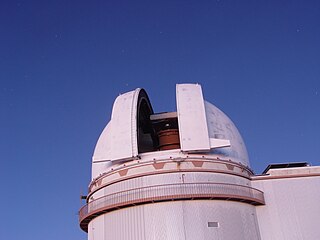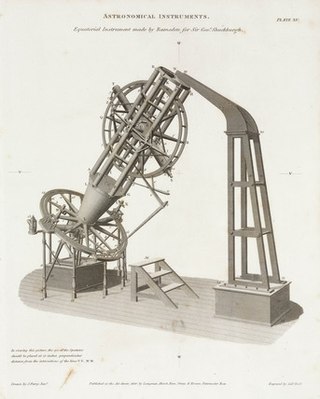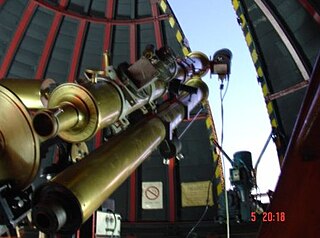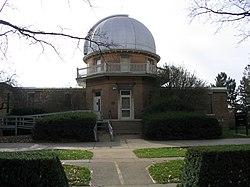
The Royal Observatory, Greenwich is an observatory situated on a hill in Greenwich Park in south east London, overlooking the River Thames to the north. It played a major role in the history of astronomy and navigation, and because the Prime Meridian passes through it, it gave its name to Greenwich Mean Time, the precursor to today's Coordinated Universal Time (UTC). The ROG has the IAU observatory code of 000, the first in the list. ROG, the National Maritime Museum, the Queen's House and the clipper ship Cutty Sark are collectively designated Royal Museums Greenwich.

Yerkes Observatory is an astronomical observatory located in Williams Bay, Wisconsin, United States. The observatory was operated by the University of Chicago Department of Astronomy and Astrophysics from its founding in 1897 to 2018. Ownership was transferred to the non-profit Yerkes Future Foundation (YFF) in May 2020, which began restoration and renovation of the historic building and grounds. Re-opening for public tours and programming began May 27, 2022.

A telescope mount is a mechanical structure which supports a telescope. Telescope mounts are designed to support the mass of the telescope and allow for accurate pointing of the instrument. Many sorts of mounts have been developed over the years, with the majority of effort being put into systems that can track the motion of the fixed stars as the Earth rotates.

The Paris Observatory, a research institution of the Paris Sciences et Lettres University, is the foremost astronomical observatory of France, and one of the largest astronomical centers in the world. Its historic building is on the Left Bank of the Seine in central Paris, but most of the staff work on a satellite campus in Meudon, a suburb southwest of Paris.

Observational astronomy is a division of astronomy that is concerned with recording data about the observable universe, in contrast with theoretical astronomy, which is mainly concerned with calculating the measurable implications of physical models. It is the practice and study of observing celestial objects with the use of telescopes and other astronomical instruments.

An equatorial mount is a mount for instruments that compensates for Earth's rotation by having one rotational axis, called polar axis, parallel to the Earth's axis of rotation. This type of mount is used for astronomical telescopes and cameras. The advantage of an equatorial mount lies in its ability to allow the instrument attached to it to stay fixed on any celestial object with diurnal motion by driving one axis at a constant speed. Such an arrangement is called a sidereal drive or clock drive. Equatorial mounts achieve this by aligning their rotational axis with the Earth, a process known as polar alignment.

Armagh Observatory is an astronomical research institute in Armagh, Northern Ireland. Around 25 astronomers are based at the observatory, studying stellar astrophysics, the Sun, Solar System astronomy and Earth's climate.

The meridian circle is an instrument for timing of the passage of stars across the local meridian, an event known as a culmination, while at the same time measuring their angular distance from the nadir. These are special purpose telescopes mounted so as to allow pointing only in the meridian, the great circle through the north point of the horizon, the north celestial pole, the zenith, the south point of the horizon, the south celestial pole, and the nadir. Meridian telescopes rely on the rotation of the sky to bring objects into their field of view and are mounted on a fixed, horizontal, east–west axis.

The Sydney Observatory is a heritage-listed meteorological station, astronomical observatory, function venue, science museum, and education facility located on Observatory Hill at Upper Fort Street, in the inner city Sydney suburb of Millers Point in the City of Sydney local government area of New South Wales, Australia. It was designed by William Weaver (plans) and Alexander Dawson (supervision) and built from 1857 to 1859 by Charles Bingemann & Ebenezer Dewar. It is also known as The Sydney Observatory; Observatory; Fort Phillip; Windmill Hill; and Flagstaff Hill. It was added to the New South Wales State Heritage Register on 22 December 2000.

The Theodor Jacobsen Observatory is the on-campus observatory of the University of Washington. Built in 1895, it is the second oldest building on campus and was constructed using the remaining Tenino sandstone blocks from Denny Hall, the oldest and first building on campus. The refracting telescope, enclosed within the dome, has a 6-inch Brashear objective lens of a Warner & Swasey equatorial mount. The observatory also includes a transit room on the west side and a -seat classroom, which was built later, on the south side.

The University of Hawaiʻi 88-inch (2.24-meter) telescope—called UH88, UH2.2, or simply 88 by members of the local astronomical community—is situated at the Mauna Kea Observatories and operated by the University's Institute for Astronomy. It was constructed in 1968, and entered service in 1970, at which point it was known as "The Mauna Kea Observatory". It became one of the first professional telescopes to be controlled by a computer. The telescope was built with funding from NASA, to support Solar System missions, and is controlled by the University of Hawaiʻi. The success of the telescope helped demonstrate the value of Mauna Kea for astronomical observations.

The Old University of Alabama Observatory, now known as Frederick R. Maxwell Hall, was an astronomical observatory owned and operated by the University of Alabama in Tuscaloosa, Alabama. Although no longer used as an observatory, the building has been restored and preserved. It currently houses the university's Collaborative Arts Research Initiative (CARI), an interdisciplinary, arts-focused research engine driven by the interests of faculty from across the university. By facilitating collaborations across disciplines, CARI maximizes the impact of faculty arts research, while enriching the university, local, and regional communities. Significant for its architectural and historical importance, it was added to the National Register of Historic Places on January 14, 1972.

The University of Illinois Astronomical Observatory, located at 901 S. Mathews Avenue in Urbana, Illinois, on the campus of the University of Illinois Urbana–Champaign, was built in 1896, and was designed by Charles A. Gunn. It was listed on the National Register of Historic Places on November 6, 1986, and on December 20, 1989, was designated a National Historic Landmark.

Fuertes Observatory is an astronomical observatory located on the North Campus of Cornell University in Ithaca, New York. The observatory was designed by L.P. Burnham, Cornell Professor of Architecture and completed in fall of 1917. It was originally used by the Civil Engineering Department as an instructional field office for navigation and surveying. Today, the observatory is primarily used for public outreach, welcoming over two thousand visitors per year with open houses on clear Friday nights.

Great refractor refers to a large telescope with a lens, usually the largest refractor at an observatory with an equatorial mount. The preeminence and success of this style in observational astronomy defines an era in modern telescopy in the 19th and early 20th century. Great refractors were large refracting telescopes using achromatic lenses. They were often the largest in the world, or largest in a region. Despite typical designs having smaller apertures than reflectors, great refractors offered a number of advantages and were popular for astronomy. It was also popular to exhibit large refractors at international exhibits, and examples of this include the Trophy Telescope at the 1851 Great Exhibition, and the Yerkes Great Refractor at the 1893 World's Fair in Chicago.

The Shuckburgh telescope or Shuckburgh equatorial refracting telescope was a 4.1 inches (10.4 cm) diameter aperture telescope on an equatorial mount completed in 1791 for Sir George Shuckburgh (1751–1804) in Warwickshire, England, and built by British instrument maker Jesse Ramsden (1735–1800). It was transferred to the Royal Observatory, Greenwich in 1811 and the London Science Museum in 1929. Even though it has sometimes not been regarded as particularly successful, its design was influential. It was one of the larger achromatic doublet telescopes at the time, and one of the largest to have an equatorial mount. It was also known as the eastern equatorial for its location.

The San José Observatory (OSJ) is an amateur astronomy observatory located in Buenos Aires, Argentina. It was founded in 1913, but was initially constructed in 1870. It is the oldest astronomical observatory in Buenos Aires which still remains in activity. The institution currently performs research and recreational activities for the public as courses or seminars.

The Crawford Observatory is a 19th-century observatory located on the campus of University College Cork, Ireland. Built in 1878, the observatory contains three instruments; a Thomas Grubb equatorial telescope, a transit telescope and a siderostatic telescope. The construction of the observatory and the purchase of telescopes was funded in part by a £1,000 donation from William Crawford, of the Beamish and Crawford brewing company.

The Observatory of the rue Serpente was an astronomical observatory owned and operated by the Société Astronomique de France in the historic Latin Quarter of Paris. It operated between 1890 until 1968, when it was transferred to a new location at the nearby Astronomy Tower of the Sorbonne.

The Linden Observatory Complex is a heritage-listed former observatory and manufacture of optical precision implements and now residence, museum, observatory, education facility and meeting venue located at 91 – 111 Glossop Road, Linden, City of Blue Mountains, New South Wales, Australia. It was designed and built by Ken Beames from 1938 to 1948. It is also known as K Beames Engineering Co. The property is owned by the Linden Observatory Trust. It was added to the New South Wales State Heritage Register on 5 March 2010.




















